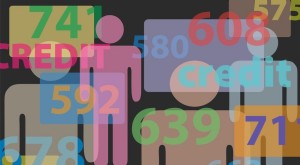Was sind die FICO Score®-Bereiche?
Wenn Sie versuchen, Ihre Kreditwürdigkeit zu verbessern, ist es wichtig zu wissen, wie Kreditgeber die Kreditwürdigkeit kategorisieren. Auf diese Weise können Sie bestimmen, wo Ihres sein sollte, um Ihre finanziellen Ziele zu erreichen.

Es ist großartig, Ihre Punktzahl um 100 Punkte zu verbessern, aber wenn Sie immer noch in der Kategorie „schlecht“ sind, werden Sie immer noch nicht viel Glück haben, für einen Kredit, eine Kreditkarte oder eine Hypothek genehmigt zu werden.
FICO®-Score-Bereich:300–850
Wie werden die FICO-Ergebnisse eingestuft? Die Kategorien können je nach Kreditgeber variieren, aber die Punktzahlen fallen normalerweise wie folgt:
Ausgezeichnete Kreditwürdigkeit:800 – 850
Es ist sehr wahrscheinlich, dass Sie für ein Darlehen oder eine Kreditkarte genehmigt werden, und Sie erhalten Zugang zu den besten Zinssätzen und Konditionen. Die höchste Kreditwürdigkeit, die Sie haben können, ist 850.
Sehr gute Bonität:740 – 799
Sie erhalten immer noch einige der besten Zinssätze, wenn Sie einen Kredit beantragen. Tatsächlich betrachten einige Kreditgeber 720 als Schwelle für die niedrigsten Zinssätze, sodass es möglicherweise nicht einmal von Bedeutung ist, ob Ihre Punktzahl höher ist.
Gute Bonität:670 – 739
Die Kreditwürdigkeit des durchschnittlichen Amerikaners beträgt 695, was in die Kategorie „gut“ fällt. In Ihrer Kreditauskunft sind wahrscheinlich nicht viele wichtige negative Punkte aufgeführt, aber es gibt Raum für Verbesserungen, um sicherzustellen, dass Sie die besten Finanzierungsbedingungen erhalten.
Fairer Kredit:580 – 669
Ihre Tarife in dieser Kategorie werden definitiv nicht die besten verfügbaren sein, was Sie Tausende von Dollar kosten könnte, wenn nicht sogar mehr, wenn Sie das nächste Mal einen Kredit aufnehmen oder ein Guthaben auf Ihrer Kreditkarte haben.
Schwache Kreditwürdigkeit:300 – 579
Sie haben definitiv einige negative Punkte und haben möglicherweise Probleme, einen Kredit zu erhalten, sei es eine neue Karte oder ein Darlehen. Wenn Sie zugelassen werden, werden Ihre Preise extrem hoch sein.
Die gute Nachricht ist, dass es in der Kategorie viel Raum für Verbesserungen gibt. Die schlechte Nachricht ist, dass Sie diese Verbesserung wahrscheinlich benötigen werden, um überhaupt für einen Kredit genehmigt zu werden. Zum Beispiel ist die absolute Mindestpunktzahl für ein FHA-Wohnungsbaudarlehen 580, wenn Sie also definitiv nicht berechtigt sind, wenn Ihr Kredit in diese Kategorie fällt.
FICO®-Bewertungstabelle
Sie wissen wahrscheinlich, wo Sie in diese Kreditkategorien fallen, aber wie steht es mit allen anderen im Land? Mit 54,7 % hat etwas mehr als die Hälfte der Bevölkerung eine Punktzahl von 700 oder mehr.
Etwa 23 % der Menschen haben eine Punktzahl zwischen 600 und 699, und 22 % der Menschen haben eine Punktzahl von weniger als 600. Das bedeutet, dass fast ein Viertel der Amerikaner entweder eine schlechte Kreditwürdigkeit hat oder kurz davor steht, unter die Schwelle von 579 zu fallen /P>
| Sehr schlecht | Schlecht | Durchschnitt | Gut | Sehr gut | Ausgezeichnet |
| 579 | 619 | 679 | 719 | 779 | 850 |
| 578 | 618 | 678 | 718 | 778 | 849 |
| 577 | 617 | 677 | 717 | 777 | 848 |
| 576 | 616 | 676 | 716 | 776 | 847 |
| 575 | 615 | 675 | 715 | 775 | 846 |
| 574 | 614 | 674 | 714 | 774 | 847 |
| 573 | 613 | 673 | 713 | 773 | 846 |
| 572 | 612 | 672 | 712 | 772 | 845 |
| 571 | 611 | 671 | 711 | 771 | 844 |
| 570 | 610 | 670 | 710 | 770 | 843 |
| 569 | 609 | 669 | 709 | 769 | 842 |
| 568 | 608 | 668 | 708 | 768 | 841 |
| 567 | 607 | 667 | 707 | 767 | 840 |
| 566 | 606 | 666 | 706 | 766 | 839 |
| 565 | 605 | 665 | 705 | 765 | 838 |
| 564 | 604 | 664 | 704 | 764 | 837 |
| 563 | 603 | 663 | 703 | 763 | 836 |
| 562 | 602 | 662 | 702 | 762 | 835 |
| 561 | 601 | 661 | 701 | 761 | 834 |
| 560 | 600 | 660 | 700 | 760 | 833 |
| 559 | 599 | 659 | 699 | 759 | 832 |
| 558 | 598 | 658 | 698 | 758 | 831 |
| 557 | 597 | 657 | 697 | 757 | 830 |
| 556 | 596 | 656 | 696 | 756 | 829 |
| 555 | 595 | 655 | 695 | 755 | 828 |
| 554 | 594 | 654 | 694 | 754 | 827 |
| 553 | 593 | 653 | 693 | 753 | 826 |
| 552 | 592 | 652 | 692 | 752 | 825 |
| 551 | 591 | 651 | 691 | 751 | 824 |
| 550 | 590 | 650 | 690 | 750 | 823 |
| 549 | 589 | 649 | 689 | 749 | 822 |
| 548 | 588 | 648 | 688 | 748 | 821 |
| 547 | 587 | 647 | 687 | 747 | 820 |
| 546 | 586 | 646 | 686 | 746 | 819 |
| 545 | 585 | 645 | 685 | 745 | 818 |
| 544 | 584 | 644 | 684 | 744 | 817 |
| 541 | 583 | 643 | 683 | 743 | 816 |
| 540 | 582 | 642 | 682 | 742 | 815 |
| 539 | 581 | 641 | 681 | 741 | 814 |
| 538 | 580 | 640 | 680 | 740 | 813 |
| 537 | 639 | 739 | 812 | ||
| 536 | 638 | 738 | 811 | ||
| 535 | 637 | 737 | 810 | ||
| 534 | 636 | 736 | 809 | ||
| 533 | 635 | 735 | 808 | ||
| 532 | 634 | 734 | 807 | ||
| 531 | 633 | 733 | 806 | ||
| 530 | 632 | 732 | 805 | ||
| 529 | 631 | 731 | 804 | ||
| 528 | 630 | 730 | 803 | ||
| 527 | 629 | 729 | 802 | ||
| 526 | 628 | 728 | 801 | ||
| 525 | 627 | 727 | 800 | ||
| 524 | 626 | 726 | 799 | ||
| 523 | 625 | 725 | 798 | ||
| 522 | 624 | 724 | 797 | ||
| 521 | 623 | 723 | 796 | ||
| 520 | 622 | 722 | 795 | ||
| 519 | 621 | 721 | 794 | ||
| 518 | 620 | 720 | 793 | ||
| 517 | 792 | ||||
| 516 | 791 | ||||
| 515 | 790 | ||||
| 514 | 789 | ||||
| 513 | 788 | ||||
| 512 | 787 | ||||
| 511 | 786 | ||||
| 510 | 785 | ||||
| 509 | 784 | ||||
| 508 | 783 | ||||
| 507 | 782 | ||||
| 506 | 781 | ||||
| 505 | 780 | ||||
| 504 | |||||
| 503 | |||||
| 502 | |||||
| 501 | |||||
| 500 | |||||
| 499 | |||||
| 498 | |||||
| 497 | |||||
| 496 | |||||
| 495 | |||||
| 494 | |||||
| 493 | |||||
| 492 | |||||
| 491 | |||||
| 490 | |||||
| 489 | |||||
| 488 | |||||
| 487 | |||||
| 486 | |||||
| 485 | |||||
| 484 | |||||
| 483 | |||||
| 482 | |||||
| 481 | |||||
| 480 | |||||
| 479 | |||||
| 478 | |||||
| 477 | |||||
| 476 | |||||
| 475 | |||||
| 474 | |||||
| 473 | |||||
| 472 | |||||
| 471 | |||||
| 470 | |||||
| 469 | |||||
| 468 | |||||
| 467 | |||||
| 466 | |||||
| 465 | |||||
| 464 | |||||
| 463 | |||||
| 462 | |||||
| 461 | |||||
| 460 | |||||
| 459 | |||||
| 458 | |||||
| 457 | |||||
| 456 | |||||
| 455 | |||||
| 454 | |||||
| 453 | |||||
| 452 | |||||
| 451 | |||||
| 450 | |||||
| 449 | |||||
| 448 | |||||
| 447 | |||||
| 446 | |||||
| 445 | |||||
| 444 | |||||
| 443 | |||||
| 442 | |||||
| 441 | |||||
| 440 | |||||
| 439 | |||||
| 438 | |||||
| 437 | |||||
| 436 | |||||
| 435 | |||||
| 434 | |||||
| 433 | |||||
| 432 | |||||
| 431 | |||||
| 430 | |||||
| 429 | |||||
| 428 | |||||
| 427 | |||||
| 426 | |||||
| 425 | |||||
| 424 | |||||
| 423 | |||||
| 422 | |||||
| 421 | |||||
| 420 | |||||
| 419 | |||||
| 418 | |||||
| 417 | |||||
| 416 | |||||
| 415 | |||||
| 414 | |||||
| 413 | |||||
| 412 | |||||
| 411 | |||||
| 410 | |||||
| 409 | |||||
| 408 | |||||
| 407 | |||||
| 406 | |||||
| 405 | |||||
| 404 | |||||
| 403 | |||||
| 402 | |||||
| 401 | |||||
| 400 | |||||
| 399 | |||||
| 398 | |||||
| 397 | |||||
| 396 | |||||
| 395 | |||||
| 394 | |||||
| 393 | |||||
| 392 | |||||
| 391 | |||||
| 390 | |||||
| 389 | |||||
| 388 | |||||
| 387 | |||||
| 386 | |||||
| 385 | |||||
| 384 | |||||
| 383 | |||||
| 382 | |||||
| 381 | |||||
| 380 | |||||
| 379 | |||||
| 378 | |||||
| 377 | |||||
| 376 | |||||
| 375 | |||||
| 374 | |||||
| 373 | |||||
| 372 | |||||
| 371 | |||||
| 370 | |||||
| 369 | |||||
| 368 | |||||
| 367 | |||||
| 366 | |||||
| 365 | |||||
| 364 | |||||
| 363 | |||||
| 362 | |||||
| 361 | |||||
| 360 | |||||
| 359 | |||||
| 358 | |||||
| 357 | |||||
| 356 | |||||
| 355 | |||||
| 354 | |||||
| 353 | |||||
| 352 | |||||
| 351 | |||||
| 350 | |||||
| 349 | |||||
| 348 | |||||
| 347 | |||||
| 346 | |||||
| 345 | |||||
| 344 | |||||
| 343 | |||||
| 342 | |||||
| 341 | |||||
| 340 | |||||
| 339 | |||||
| 338 | |||||
| 337 | |||||
| 336 | |||||
| 335 | |||||
| 334 | |||||
| 333 | |||||
| 332 | |||||
| 331 | |||||
| 330 | |||||
| 329 | |||||
| 328 | |||||
| 327 | |||||
| 326 | |||||
| 325 | |||||
| 324 | |||||
| 323 | |||||
| 322 | |||||
| 321 | |||||
| 320 | |||||
| 319 | |||||
| 318 | |||||
| 317 | |||||
| 316 | |||||
| 315 | |||||
| 314 | |||||
| 313 | |||||
| 312 | |||||
| 311 | |||||
| 310 | |||||
| 309 | |||||
| 308 | |||||
| 307 | |||||
| 306 | |||||
| 305 | |||||
| 304 | |||||
| 303 | |||||
| 302 | |||||
| 301 | |||||
| 300 |
Why Good Credit Matters
It’s important to have a good credit score as high as possible because the higher your interest rate, the more money you’ll pay over time. That can really add up for high-value loans like cars or mortgages.
Let’s look at a quick example. If you have excellent credit and take out a mortgage for $100,000 over 30 years and your rate is a low 3.92%, you’ll end up paying an additional $70,000 in interest payments.
If you think that’s a lot of money, wait until you see the next set of numbers. Bump that rate up to 5.92% for someone with a lower credit score, and they’ll end up paying over $113,000 in interest. That’s more than the loan itself! And it’s $43,000 more than the first person paid with a better interest rate.
The High Cost of Bad Credit
Even if you’re not planning on buying a home anytime soon, the same principles apply to credit cards, car loans, student loans, and other loans. The lower your credit score, the more money you’ll have to pay. Plus, landlords and even some employers now do credit checks as part of their application processes.
With a bad credit score, you might have difficulty finding a home or even a job. And if you have a financial emergency, you might be stuck with high-fee options like payday loans or title loans, which can add up fast and even cost you your car.
If you fall into one of the lower credit rankings, it’s time to start evaluating your credit reports. That way you can find out how you can improve that score and keep your financial opportunities wide open.
Industry Specific Credit Scores
Now that you know what a good credit score is, it’s time to get more specific.
Traditional FICO scores from the popular scoring company Fair Isaac Corporation range from 300 to 850. However, there are actually several credit scoring models that lenders might use when judging your creditworthiness. These vary depending on what type of credit you’re applying for.
A few examples include versions specifically for mortgages, car loans, credit cards, and student loans. Each one will look at slightly different information that is more relevant to the exact type of credit you want.
Your Credit Scores Are Different Depending on What You Apply For
The model for credit cards more heavily weighs your revolving payment history, while the auto-version is going to pay more attention to your past car payments.
There are a couple of tricky parts that come with these alternative scoring models. The first is that you probably won’t know which credit scoring model your lender is going to use unless you ask.
Additionally, the credit score ranges are different from the traditional FICO model. Instead of ranging between 300 and 850, the industry-specific scores range between 250 and 900.
On the auto credit range, for example, you’ll want at least a 750 to get the best interest rates. So, you can see how the numbers vary slightly for each different model.
FICO vs. VantageScore
While FICO scores are the most popular ones used by lenders today, there are other companies competing in this space. The other major model is called VantageScore, which was actually created by the three credit bureaus.
VantageScore 2.0, which is still used by some lenders, calculates credit anywhere between 501 and 990.
The latest version, VantageScore 3.0, uses the same range as FICO to reduce confusion, 300–850. Just like FICO, the higher score you have on both types of VantageScore models, the better a lender views your credit.
What Else Do Lenders Look at Besides Credit Score?
Clearly, your credit score is a massive component of any financial application process. If you don’t meet certain minimums, there’s no way you’ll get approved or access the very best rates. That being said, lenders look at a lot of additional information beyond your credit score and credit report.
They also analyze your income level to make sure you can afford the loan amount you’ve requested. Even if you earn six figures, if you have too much debt or the loan amount is too high, the lender might question your ability to make your payment each month.
Employment History
They also look at your employment history. No matter how great your credit is, or how much money you make, most lenders want to see that you’ve been in the same job (or at least the same industry) for the past two years. They even check your tax statements and pay stubs to confirm your earnings and often require proof of employment.
A lender might also want to know how much in cash reserves you have on hand. They’ll likely want to see bank statements because the more savings you have, the more cushion you have to repay the loan even if you have a financial emergency, like medical bills or a lost job.
How to Get the Best Credit Score
Start by consistently paying all of your bills on time and in full. This is the best thing you can do for your credit score because it accounts for 35%—the biggest factor considered!
You should also order a free copy of your credit report to get an idea of what exactly is bogging down your score. Is there anything on there that’s incorrect or out of date? You might be able to dispute it and have it removed.
In the event you have multiple negative items, you could greatly benefit from talking to a credit repair company to help you clean up your credit history.
Get a Free Credit Consultation
Most companies, like Lexington Law Firm, offer a free consultation so you can ask questions about your specific situation and find out exactly what they can help you with.
Knowledge is power, and finding out your credit score and learning what range you fall in can help you plan the next steps in your financial future.
Never assume the worst-case scenario; there’s no such thing as a lost cause. Everyone, no matter how bad their credit score is, has the potential to improve their financial situation.
It might take a little time and effort, but it’s always doable. Professional credit repair companies that have been in the business for a long time have truly seen it all. Don’t be afraid to give one a call today and find out what you can do to increase your credit score.
Sind Sie bereit, Ihre Kreditwürdigkeit zu erhöhen?
Fordern Sie eine kostenlose Kreditberatung an!
Bankgeschäfte
- Was ist R1 &I1 in der Kreditauskunft?
- Welche Abmessungen hat eine Kreditkarte?
- Was sind die Elemente des Kredits?
- Was sind die Vorteile von Geld leihen?
- Was sind die Ähnlichkeiten zwischen Banken und Kreditgenossenschaften?
- Was ist die minimale Kreditwürdigkeit, um ein Haus zu kaufen?
- Was ist ein Kredit-Score?
- Was sind die verschiedenen Arten von Schulden?
- Was ist die höchste Kreditwürdigkeit?
-
 Was ist die höchste Kreditwürdigkeit, die Sie bekommen können?
Was ist die höchste Kreditwürdigkeit, die Sie bekommen können? Der Standardkreditbereich für die beliebtesten Kreditbewertungsmodelle, FICO und VantageScore, liegt zwischen 300 und 850. Diese Bandbreite hat viele Menschen zu der Annahme veranlasst, dass sie einen...
-
 Was ist ein FICO-Score?
Was ist ein FICO-Score? Wenn Sie schon einmal versucht haben, einen Kredit aufzunehmen oder eine Kreditkarte beantragt haben, haben Sie den Begriff „FICO-Score“ wahrscheinlich mehr als einmal gehört. Wenn Sie jedoch gerade...


